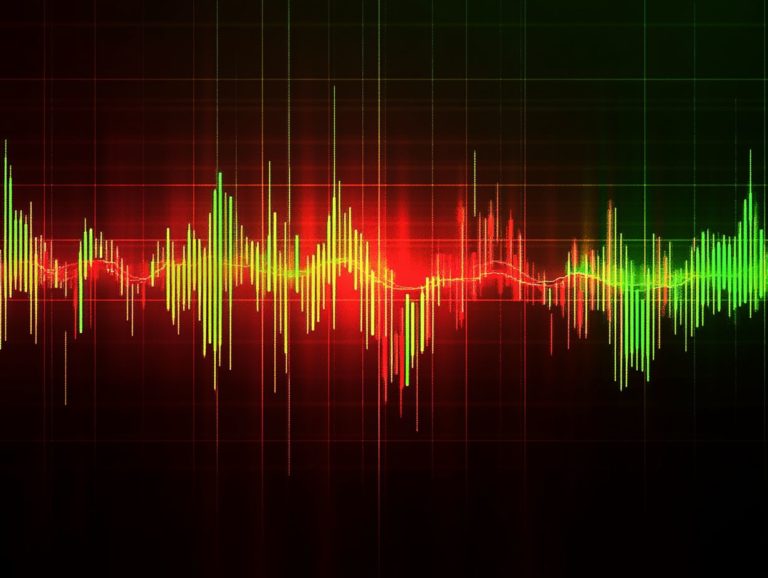Top 5 Technical Indicators for Stock Trading
In the fast-paced world of stock trading, making informed decisions is essential for your success. One effective way to analyze market trends and price movements is through technical indicators, which are tools used to analyze market data. This article delves into the top five technical indicators Moving Averages, Relative Strength Index (RSI), Bollinger Bands, Stochastic Oscillator, and MACD that can elevate your trading strategy.
It also sheds light on what technical indicators are, how they operate, their benefits and limitations, and offers tips for selecting the right ones. Whether you re just starting out or you ve got years of experience, grasping these tools can significantly enhance your trading performance. Get ready to boost your trading game!
Contents
- Key Takeaways:
- 1. Moving Averages
- 2. Relative Strength Index (RSI)
- 3. Bollinger Bands
- 4. Stochastic Oscillator
- 5. MACD (Moving Average Convergence Divergence)
- What Are Technical Indicators and How Do They Work?
- What Are the Different Types of Technical Indicators?
- How Can Technical Indicators Help with Stock Trading?
- What Are the Limitations of Technical Indicators?
- How Can One Choose the Right Technical Indicators for Their Trading Strategy?
- What Are the Common Mistakes to Avoid When Using Technical Indicators?
- Frequently Asked Questions
- What are the top 5 technical indicators for stock trading?
- How do moving averages help in stock trading?
- What is the purpose of using the Relative Strength Index (RSI) in stock trading?
- How do Bollinger Bands assist in stock trading?
- What role does the Stochastic Oscillator play in stock trading?
- What does the MACD indicator indicate in stock trading?
Key Takeaways:

- Moving averages help identify trends and provide support/resistance levels.
- RSI indicates overbought/oversold conditions and potential trend reversals.
- Bollinger Bands show volatility and potential breakouts or pullbacks.
1. Moving Averages
Moving averages are essential technical indicators that help you identify price trends and confirm market movements. They offer valuable insights that inform your trading decisions in the ever-shifting landscape of financial markets.
You ll typically encounter two main types of moving averages: the Simple Moving Average (SMA) and the Exponential Moving Average (EMA). The SMA calculates the average price over a specified period, providing a smooth line that filters out daily price fluctuations. The EMA, however, gives more importance to recent prices, allowing it to respond more swiftly to price changes.
These averages generate buy and sell signals. For example, when the price crosses above the SMA, it may indicate a potential buying opportunity. Conversely, a cross below might suggest it s time to sell. Traders often leverage these averages to gauge market dynamics and manage risk, refining their entry and exit points.
2. Relative Strength Index (RSI)
The Relative Strength Index (RSI) is a powerful momentum oscillator that captures the speed and change of price movements. It allows you to identify overbought and oversold conditions in the market.
By analyzing the RSI, you can gauge market sentiment and make informed decisions about your trade entries and exits. For instance, if the RSI climbs above 70, it may signal that the asset is overbought, hinting at a potential reversal. An RSI reading below 30 suggests the asset might be oversold, indicating a possible bullish reversal.
Traders respond to these signals, which influences market behavior. Understanding how the RSI interacts with market participants enables you to gain deeper insights into your trading strategies.
3. Bollinger Bands
Bollinger Bands are advanced tools for measuring price fluctuations. They feature a central line flanked by two outer bands, helping you evaluate price movements in relation to volatility and trading volume.
By connecting price action with volatility, these indicators can illuminate potential buying or selling opportunities. When the price grazes the lower band, it may hint at an oversold condition, signaling that a buy could be on the horizon. Conversely, when the price approaches the upper band, it may suggest an overbought scenario, acting as a cue for a possible sell.
To elevate your trading strategies, consider pairing Bollinger Bands with other technical indicators like the Relative Strength Index (RSI) or Moving Average Convergence Divergence (MACD). This combination enhances the reliability of your entry and exit points, leading to more informed trading decisions. Understand these indicators now to stay ahead of the market!
4. Stochastic Oscillator

The Stochastic Oscillator is a useful momentum indicator. It helps you compare the current price of an asset to its historical performance.
This comparison allows you to identify overbought and oversold conditions. If the oscillator shows values above 80, the asset may be overbought, indicating a potential price correction.
Conversely, readings below 20 suggest that the asset might be oversold, creating a chance for a price rebound.
As a trader, interpreting these signals with other indicators enhances your strategy. This way, you can gauge market sentiment and identify potential reversals.
5. MACD (Moving Average Convergence Divergence)
The MACD, or Moving Average Convergence Divergence, is an essential technical indicator. You can use it to identify trend direction, duration, and shifts in momentum by examining the relationship between two moving averages.
At its core, the MACD consists of the MACD line, calculated as the difference between the 12-day and 26-day exponential moving averages (EMAs), and the signal line, which is typically a 9-day EMA of the MACD line itself. This relationship allows you to monitor crossovers between these lines as potential buy or sell signals.
The histogram visually shows the distance between these two lines, indicating momentum strength.
Analyzing these signals helps you confirm trends and anticipate reversals, empowering you to make smart decisions about your entry and exit points.
What Are Technical Indicators and How Do They Work?
Technical indicators are useful tools in your trading toolkit. They analyze price history and trading volume, enabling you to make informed decisions.
These indicators streamline your decision-making process by providing insights into past market behavior. They help you pinpoint trends, gauge momentum, assess volatility, and analyze trading volume all essential for crafting effective trading strategies.
Several types of technical indicators can enhance your trading prowess, including:
- Moving averages
- Relative Strength Index (RSI)
- Bollinger Bands
- On-Balance Volume (OBV)
Together, these indicators give you a clearer picture of market conditions. They enable you to optimize your entry and exit points with greater precision.
What Are the Different Types of Technical Indicators?
Technical indicators can be classified into several categories: trend indicators, momentum indicators, volatility indicators, and volume indicators. Each serves distinct purposes in your trading analysis.
These indicators are essential for making informed decisions by helping you identify potential market movements and trends. Trend indicators focus on the direction of asset prices, guiding you on when to enter or exit positions based on upward or downward trends.
Momentum indicators gauge the speed of price changes, signaling potential reversals and allowing you to grasp market strength.
Volatility indicators assess price fluctuations over time, offering insights into market stability or imminent shifts. Volume indicators highlight the trading activity of an asset, revealing the strength behind price movements.
By skillfully utilizing these indicators, you can develop robust strategies backed by meaningful chart patterns, enhancing your profitability.
How Can Technical Indicators Help with Stock Trading?

Technical indicators empower you to make smart trading decisions. They provide key insights into market trends, helping you identify when to buy or sell.
These tools allow you to find the best entry and exit points by analyzing price movements and volume patterns over time. For example, moving averages can help determine the trend’s direction, while oscillators can signal potential overbought or oversold conditions.
Incorporating these indicators into a comprehensive trading strategy enables you to evaluate market dynamics, adjust your positions, and effectively manage risks. This approach deepens your understanding of market behavior and fosters a disciplined trading routine that aligns with your financial goals.
What Are the Limitations of Technical Indicators?
While technical indicators are valuable tools, they have limitations. They can generate false signals and often overlook the constantly changing market dynamics that can influence trading decisions.
Many believe that relying solely on these indicators guarantees profit. This narrow view can lead to missed opportunities and increased risk. Psychological factors that influence market participants can shift quickly, affecting price movements in ways that technical analysis can’t always predict.
If you ignore fundamental analysis, you might miss crucial economic data or company news that could significantly alter market conditions. By blending technical insights with a broader understanding of market sentiment and fundamental factors, you can make more informed decisions that reflect the complexities of the real world.
How Can One Choose the Right Technical Indicators for Their Trading Strategy?
Selecting the right technical indicators is crucial for creating an effective trading strategy. Different indicators align with various market sentiments, risk management approaches, and trading volume considerations.
With so many options available, evaluate your unique trading goals and style to find indicators that resonate with your approach. For example, if you prefer a trend-following strategy, moving averages may be particularly beneficial in identifying market direction and strength.
If you’re a day trader, volatility indicators like the Average True Range (ATR) can help gauge price fluctuations and pinpoint optimal entry and exit points.
Understanding the underlying market conditions can further enhance your decision-making. In trending markets, momentum indicators like the Relative Strength Index (RSI) provide valuable insights into potential reversals or continuations, refining your trading approach and increasing effectiveness.
What Are the Common Mistakes to Avoid When Using Technical Indicators?
Traders often stumble over common pitfalls when using technical indicators, particularly when they use these tools without understanding the underlying market psychology and fail to adapt their strategies to current conditions.
This over-reliance can lead to misinterpreting signals; for instance, you might see a bullish indicator but overlook broader market trends that could change the context entirely. Trying to track too many indicators at once can create a cacophony of conflicting signals, leaving you more confused than informed.
To improve your trading outcomes, streamline your indicator set and focus on a few that truly align with your strategy. Regularly reviewing your trades can reveal patterns of error, enabling you to make informed adjustments that cultivate a disciplined trading approach.
Frequently Asked Questions

What are the top 5 technical indicators for stock trading?
The top five technical indicators for stock trading are:
- Moving Averages
- Relative Strength Index (RSI)
- Bollinger Bands
- Stochastic Oscillator
- MACD
How do moving averages help in stock trading?
Moving averages smooth out price data and help identify trends. They can act as support or resistance levels and indicate potential entry or exit points for trades.
What is the purpose of using the Relative Strength Index (RSI) in stock trading?
The RSI measures the speed and change of price movements. This helps traders spot overbought or oversold conditions that may signal potential price reversals.
How do Bollinger Bands assist in stock trading?
Bollinger Bands show the volatility of a stock’s price compared to its moving average. They help traders identify possible breakouts or breakdowns in price.
What role does the Stochastic Oscillator play in stock trading?
The Stochastic Oscillator measures the momentum of price movements. It helps traders determine potential entry or exit points based on overbought or oversold conditions.
What does the MACD indicator indicate in stock trading?
The MACD shows the relationship between two moving averages. It helps traders identify trend changes, divergences, and potential buy or sell signals.





